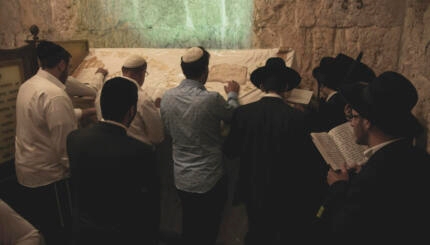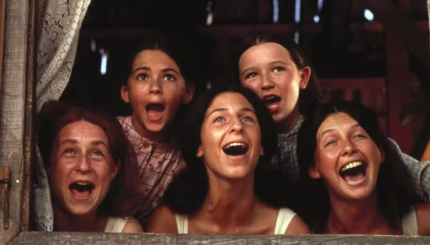Orthodox women’s tefillah (prayer) groups consist of women who wish to maximize women’s participation in communal prayer while remaining within the halakhic parameters of the Orthodox community, and so meet regularly to conduct prayer services for women only.
The first women’s group began in the late 1960s on the holiday of Simhat at Lincoln Square Synagogue in Manhattan. Simhat Torah had proved to be a particularly frustrating experience for Orthodox women as all of its customs and celebrations are tied to the synagogue and formal prayer. Perhaps even more critical was the fact that celebration focused on carrying, dancing, and rejoicing with the Torah scrolls, a practice from which women were excluded.
With the support of its rabbi, Shlomo Riskin, the women of Lincoln Square Synagogue were given Torah scrolls for the celebration and permitted to convene a separate Torah reading. Subsequently, it was seen as a major step forward when women in other Orthodox synagogues were also granted the privilege of holding the Torah and taking it to the women’s section. Many groups progressed to conducting full-fledged Simhat Torah services for women only–services in which women read the Torah portion aloud and gave aliyot to every woman present.
The Movement Grows
By the late 1970s, a number of groups began to meet monthly. Some of these prayer services were tied to rosh chodesh (the beginning of the month) and the new moon cycle and met on weekdays, while others met once a month on . In 1978 and 1979, tefillah groups were formed in Baltimore, Maryland; in St. Paul, Minnesota; and in Riverdale and Washington Heights, New York. In the early 1980s, the first women’s tefillah group in Canada was founded, shortly followed by the Flatbush group in Brooklyn, New York.

Help us keep Jewish knowledge accessible to millions of people around the world.
Your donation to My Jewish Learning fuels endless journeys of Jewish discovery. With your help, My Jewish Learning can continue to provide nonstop opportunities for learning, connection and growth.
During this period, most women’s tefillah groups met in private homes, as Orthodox synagogues were not prepared to sanction the practice. Two notable exceptions in New York were the Riverdale group, which was invited by Rabbi Avi Weiss to meet in the Hebrew Institute of Riverdale, a major Orthodox synagogue, and an East Side group which met in Kehillat Jeshurun under the guidance of Rabbi Haskel Lookstein.
Opposition and Responses to Women’s Tefillah
Mainstream modern Orthodox rabbis and community leaders rejected women’s tefillah groups for reasons that ranged from the halakhic to the sociological. This issue came to a head in 1985 with publication of the “Teshuva: Responsum” by five highly regarded Yeshiva University rabbis. The position paper viewed the movement as stemming from, and copying, the feminist movement in America with no serious spiritual or religious basis. It prohibited all organized women’s prayer groups in any form.
 The reaction to this public statement was dramatic. Although some rabbis used the statement to justify their prohibition of these prayer groups, a number of well-respected Orthodox rabbinic leaders viewed the document as totally subjective and without serious halakhic basis. This spurred them to take more public roles and action in support of the growing movement. Subsequently, a book was published by Rabbi Weiss entitled Women and Prayer, which analyzed and supported women’s tefillah from a halakhic perspective.
The reaction to this public statement was dramatic. Although some rabbis used the statement to justify their prohibition of these prayer groups, a number of well-respected Orthodox rabbinic leaders viewed the document as totally subjective and without serious halakhic basis. This spurred them to take more public roles and action in support of the growing movement. Subsequently, a book was published by Rabbi Weiss entitled Women and Prayer, which analyzed and supported women’s tefillah from a halakhic perspective.
Also as a response, the Women’s Tefillah Network (WTN) was born. Through 2000 the network served as a support and resource center for new and existing groups, published regular newsletters, counseled groups, and provided groups with written and taped prayer guides. By the late 1980s, women’s tefillah groups proliferated throughout New York and spread to isolated venues throughout North America. It was difficult to ascertain the exact number of groups. Since the climate was so hostile, many existed “underground.” By 1988, it was estimated that there were twenty groups, and in January of 1997 there were over forty identifiable groups in the United States, Canada, Israel, England, and Australia. These represented nearly four thousand women.
According to the WTN, as of 2000 there were 33 women’s tefillah groups in the United States (twenty-two of which were in New York), as well as 57 other groups worldwide, including three in Canada, seven in Israel, two in England, and one in Sydney, Australia. With the formation of the Jewish Orthodox Feminist Alliance (JOFA) that same year, many of the WTN’s services and roles were taken over by the newer, larger organization, and the network itself became less necessary and hence less active.
The advent of Orthodox im that permit a greater participation for women (based on the widely circulated article by Rabbi Mendel Shapiro, originally published in The Edah Journal, 2001) is having a significant impact on the direction of women’s tefillah groups, and so it is unclear what the future role of the groups will be within the Orthodox community.
Structure
Women’s prayer groups meet monthly to pray, read Torah, and study together. Most groups meet on Shabbat mornings, while others meet on Shabbat afternoons or Rosh Hodesh weekdays. Generally, full Torah and haftarah portions are read. The women conduct a full service based on guidelines set by their local rabbis. For the most part, women’s tefillah groups do not function as a minyan. This means that they omit specific prayers for which a minyan is required. Thus the status of these groups remains different from that of their male counterparts.
 Women’s tefillah groups have become a new arena for women’s life cycle events within the Orthodox community. Celebrations held include simhat bat ceremonies celebrating the birth of a baby girl, bat mitzvah ceremonies, and “aufrufs” (lit. “calling up,” an honorary
on the Shabbat before one’s wedding) for women about to be married. Among the unique practices that have resulted from these groups is the inclusion of a prayer for agunot, women denied religious divorce.
Women’s tefillah groups have become a new arena for women’s life cycle events within the Orthodox community. Celebrations held include simhat bat ceremonies celebrating the birth of a baby girl, bat mitzvah ceremonies, and “aufrufs” (lit. “calling up,” an honorary
on the Shabbat before one’s wedding) for women about to be married. Among the unique practices that have resulted from these groups is the inclusion of a prayer for agunot, women denied religious divorce.
The tefillah groups are attended by women of every age and religious background. Young mothers with babies, older women, preadolescents, teenagers, and college students all participate. This forum allows each of them unique entry into the world of prayer. For some women it affords the opportunity to learn and practice new synagogue skills; for some it provides an opportunity to serve as role models for their children; for some it is a doorway back to the Orthodox community; for some it is a natural extension of leadership that they experience in other areas of their lives.
As feminism continues to influence American Orthodoxy, women’s tefillah groups will remain a viable alternative for Orthodox women who desire a fuller worship experience without leaving Orthodoxy.
Reprinted from the Shalvi/Hyman Encyclopedia of Jewish Women with permission of the author and the Jewish Women’s Archive.


